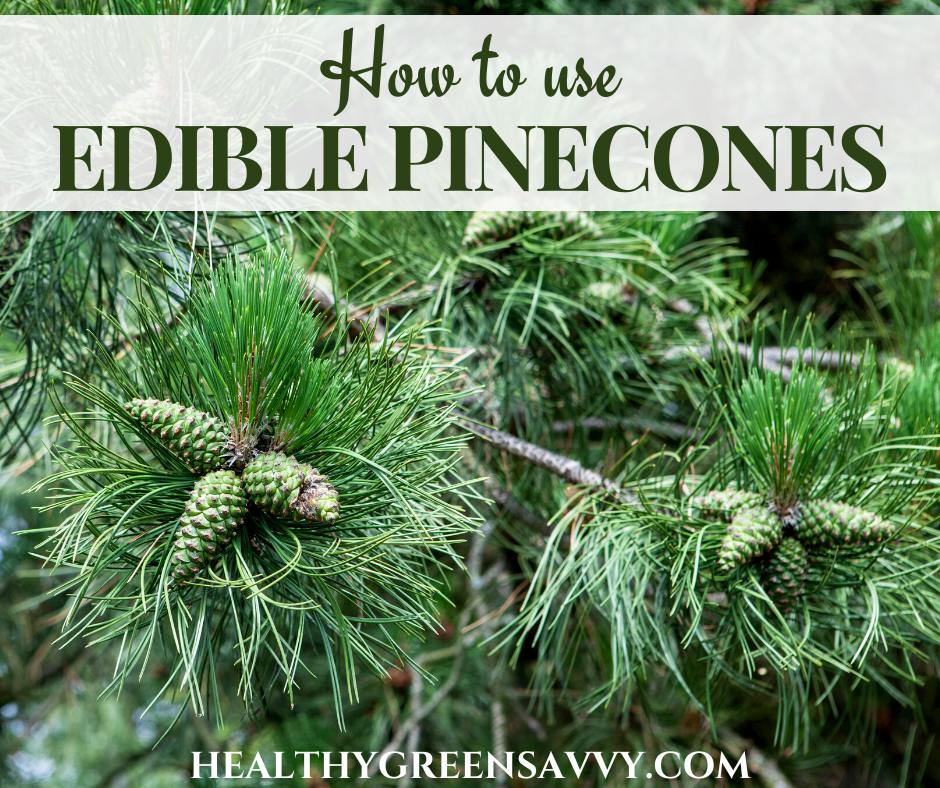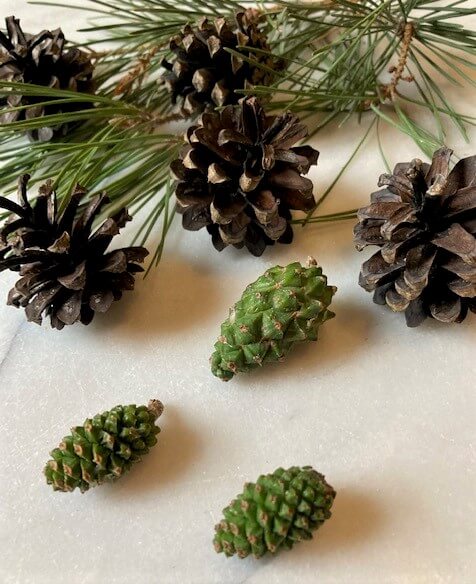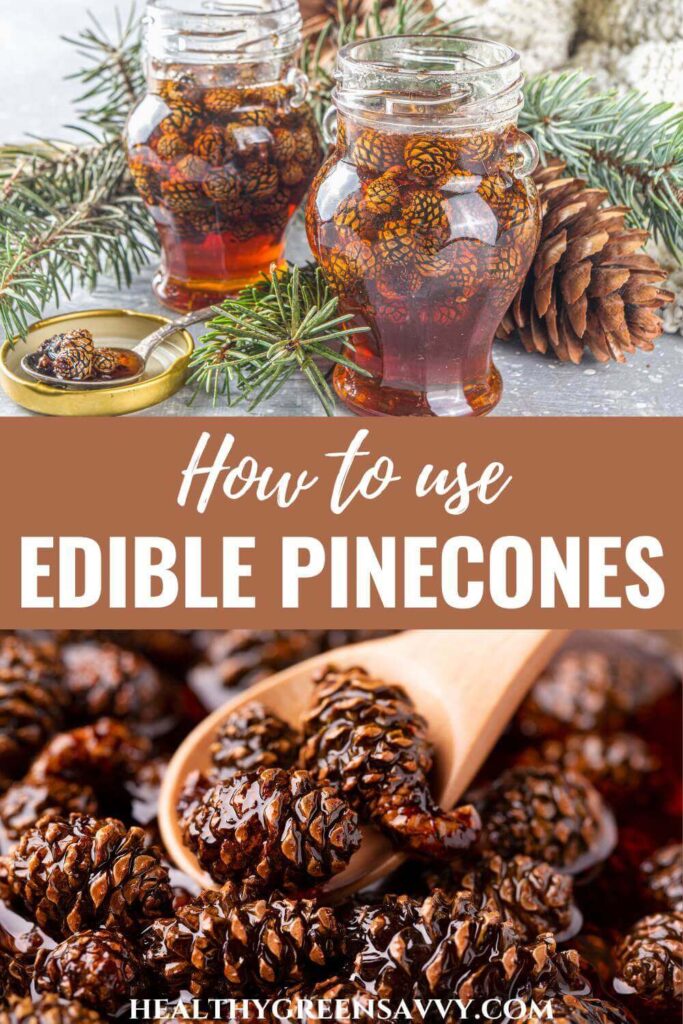Last Updated on September 23, 2024
Looking for something to forage in winter? If you’ve been eyeing those pine cones dangling from nearby trees, know you’re not alone in wondering whether pine cones are edible. Here’s what to know about edible pine cones before you dig in.

SO CAN YOU EAT PINE CONES?
The question of whether pine cones are edible is a little bit complicated since the answer varies with the time of year and type of tree.
A lot of posts purporting to answer the question about whether you can eat pine cones actually dodge it and talk instead about eating the seeds, better known as pine nuts. Edible nuts can only be found in certain species of pine growing in select regions of the world and they’re notoriously difficult to forage.
I’m going to try to answer the question you were actually asking and discuss the more common pine cones you’re likely to find in your neighborhood.
And just to be clear, today we’re talking about pine cones, not spruce or fir cones, though spruce cones are also used as food and medicine and young fir cones are also edible. Don’t know how to tell them apart? Here’s how to identify spruce vs fir vs pine.
As you might guess, those hard, woody pine cones you pick up off the ground to use as holiday decorations are not edible — not because they’re toxic, but because they’re simply too tough to eat. If you try to chew on one, you’ll figure that out right away.
Some really determined folk have ground mature pine cones into a flour-like substance that could be added in very tiny amounts to baked goods, but I doubt they added much besides bulk and fiber to the finished product.
But perhaps you’ve noticed that earlier in the growing season, pine cones look really different. They’re green and solid rather than brown with lots of scales poking out, like the ones we put out for decoration. It’s these young, immature pine cones that are worth getting to know for the would-be pine cone forager.

So if you’re reading this in winter, you’re better off collecting the needles from spruce and pine, which are tasty at all times of year. You can make spruce tea or pine needle tea, or a fun pine syrup that can work as a cocktail mixer or a useful remedy for cough. (Here are loads more herbs for coughs if you’re curious.)
In late spring, be on the lookout for the tasty young tips of the spruce tree (spruce tips), which can be used in many interesting spruce tip recipes.
WHAT EXACTLY ARE PINE CONES, ANYWAY?
Cones are what give us the name ‘conifer,’ which simply means a cone-bearing plant. Pine trees produce cones to protect their seeds, which they release in warm weather. The scaly brown pine cone you’re likely familiar with is a female cone, which contains the seed.
Female cones are pollinated by male cones, which are smaller, softer and filled with pollen. They don’t stick around the way the female cones do.
The immature cones of spruce trees may be eaten in ways very similar to those of pines.
WHAT DO PINE CONES TASTE LIKE?
Like other parts of the pine, young pine cones have a resinous pine-y flavor that mellows as the cones age. When infused into alcohol or syrup, they produce a forest-y tasting infused liquid. The smallest cones will yield a very strongly flavored syrup, so you may want to let them size up a little before harvesting.
If you cook the youngest cones in water and sugar for several hours, they can become a bit like a chewy candy. You’ll find links to recipes at the end of the post.
ARE PINE CONES GOOD FOR YOU?
Like other parts of the pine tree, pine cones contain compounds used as medicine by people around the world. Modern science has explored these uses, finding that compounds contained in pine cones may help with respiratory illnesses.
One study concludes that oils obtained from needles and cones of Pinus mugo “can be considered as promising agents for anticancer and anti-inflammatory drugs.”
Of course, if you’re preparing them with the copious amounts of sugar most pine cone recipes call for, they’re not exactly a health food, though they may make a useful cough syrup.
WHEN TO GATHER EDIBLE PINE CONES

The most important thing to know if you want to eat pine cones is that you gather them early in the season. If you’re reading this post in winter, you’ll want to bookmark it and return to it in late spring, when the little green cones start forming.
A few survivalist websites suggest you might boil and soften the hard, brown cones, but they were rather short on details about how that works out. If you try eating a mature pinecone, please leave a comment and let the rest of us know how it went!
The youngest pine cones will be the most tender and easy to consume, while immature cones gathered later on will be tougher and will likely be used to flavor what you make rather than consumed directly.
Once they turn brown and woody, they’re not food anymore. Use the needles to brew tea instead and make a mental note to come gather edible pine cones the following spring.
Want to learn more about foraging a huge range of edible wild plants? Add some of the best foraging books to your collection and consider taking a class, like the Herbal Academy’s online foraging course, which covers plant identification, ethical wildcrafting, and much more.
HOW TO EAT PINE CONES
So you won’t want to just cut into a pine cone and chow down like you might with an apple. Though I have seen foragers nibble tiny male cones right off the tree, foraging expert Steve Brill’s description of their taste may make you hesitate. He proclaims the pollen cone
as bad as the inner bark. Although some individuals like it, the next time I consume it will be when I’m lost and starving, with a case of selective amnesia that makes me forget every other wild food.
Makes you want to run out and try, them, right? In general, you’re going to enjoy pine cones most if you use the young female cones to infuse flavor into something else.
Young female pine cones contain some of the same compounds and flavors as pine needles, which are typically what’s used to flavor pine syrup.
The most common way to use immature edible pine cones is in a syrup made with young pine cones and sugar. Some people call it “jam” and eat the cooked, candied pine cones, while others leave the cones in as decoration but only use the syrup.

Pine cone syrup is used like honey on bread or waffles as well as for medicinal purposes, like soothing a cough or sore throat. Like pine needle syrup and pine needle tea, pine cone syrup may have beneficial effects on respiratory illnesses.
If your hands get all sticky collecting and preparing your young pine cones, isopropyl alcohol will take the resin right off.
Note that if you catch them at just the right time, male cones will contain pine pollen, considered a delicacy and used as a high-protein flour. Here’s more on using pine pollen from Hunter, Angler, Gardener, Cook. Forager Chef makes fudge from it.
Check out the pine cone recipes below for more details on using edible pine cones.
WHAT TO DO WITH EDIBLE PINE CONES: PINE CONE RECIPES
Now that you’ve gathered up some young edible pine cones, what to do with them?
♦ A traditional pine cone syrup is made by packing pine cones in sugar for about a month. This video from Forager Chef walks you through the process. The cones are strained from the syrup, which can then be used in place of honey and drizzled on pancakes, toast, or yogurt, or used in salad dressings.
♦ If you’ve got very young pine cones, you can make a pine cone preserve (a traditional Russian recipe often referred to as pine cone jam or varenye) by cooking them in sugar and water. Recipe from London chef here.

♦ You can use sliced young pine cones to make tea by simmering them in a little water.
♦ If you’re after a more concentrated medicine made from pine cones, you can use chopped green pine cones to make a tincture. Here’s what to know about making tinctures from Herbal Academy. You can adapt this pine needle tincture recipe as well.
♦ Similar to a tincture, an Austrian concoction called zirbenschnaps (pine cone schnapps) is made by steeping green cones from the Arolla pine in alcohol.
If you’re too late to find pine cones still at the edible stage, you might seek out wild foods you can still forage when plants have gone to sleep for the winter. In addition to the conifer teas mentioned above, here are some to explore:
Find loads more edible wild plants in our foraging archives.
Have you ever eaten pine cones? What did you think of them?
Pin to save this answer to the question, ‘Are pine cones edible?‘ for later.

Can you eat pine cones additional photo credits: Cover — Magmos; pin — malyugin
Disclaimers: Though HealthyGreenSavvy and EcoSavvy Writing LLC always aim to provide thorough and accurate information, we assume no liability or responsibility for any consequences, health issues, or symptoms that arise from ingesting or touching any plant described on this website. It is always the reader’s responsibility to ensure accurate plant identification and use multiple reputable sources to confirm. If you have any doubts about the identification of any plant, do not eat it.

Susannah is a proud garden geek and energy nerd who loves healthy food and natural remedies. Her work has appeared in Mother Earth Living, Ensia, Northern Gardener, Sierra, and on numerous websites. Her first book, Everything Elderberry, released in September 2020 and has been a #1 new release in holistic medicine, naturopathy, herb gardening, and other categories. Find out more and grab your copy here.


 Hi, I'm Susannah, a garden geek, energy nerd, and fan of healthy food and natural remedies. Need some simple, practical solutions for living healthier and greener? You've come to the right place! More about me and my green projects
Hi, I'm Susannah, a garden geek, energy nerd, and fan of healthy food and natural remedies. Need some simple, practical solutions for living healthier and greener? You've come to the right place! More about me and my green projects
Kirsten says
HI,
Thank you very much for this post. I have grated a green (I think) male pine cone, which was quite hard to do.
Then I baked it in oil with a bit of onion. It tasted deliciously!
And it made my lungs work a bit better.
As it was so hard to grate, I am looking online for ground cones, but theyis not easy to find.
Susannah says
How interesting! Just onions and cones? More details on the recipe please!
I’ve found the green cones aren’t too difficult to cut with a knife, but I wonder if you could try cooking first, then chopping (rather than grating) if they’re really hard?
joan says
I’ve sauted cones in butter, then added maple syrup and continued simmering until carmelized. Chop them and toss on salads, or on fish before baking. With honeyed cones, it can be a marinade for fish or poultry.
Susannah says
Sounds yummy!